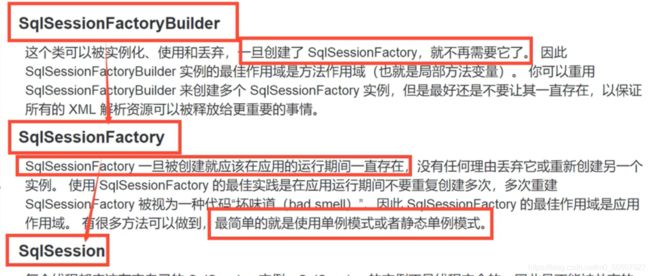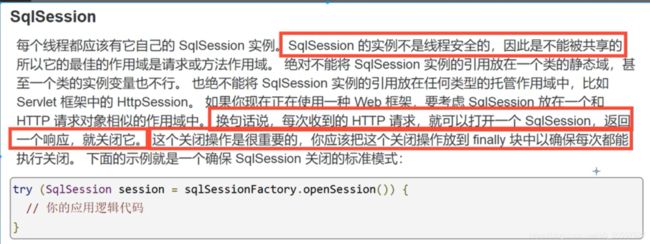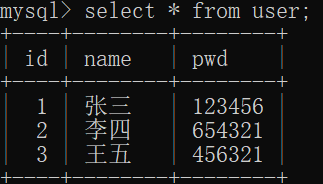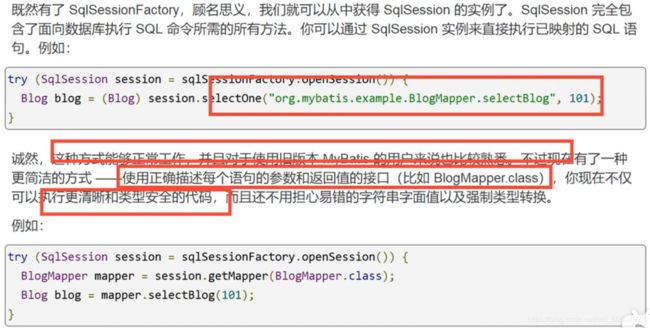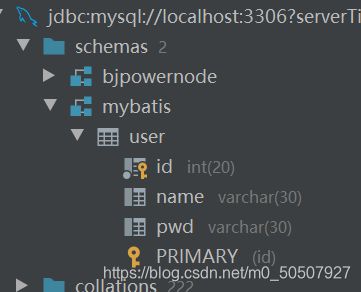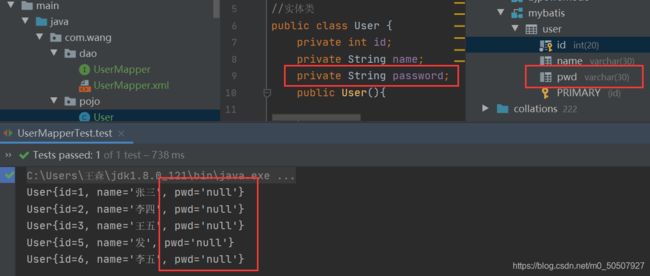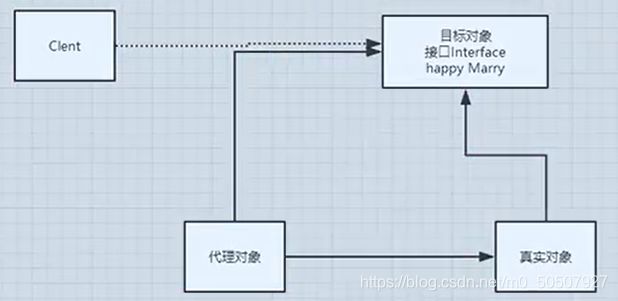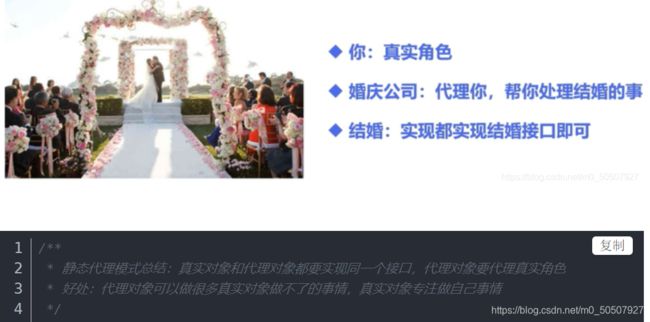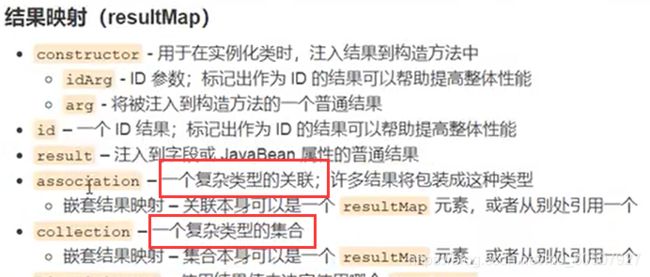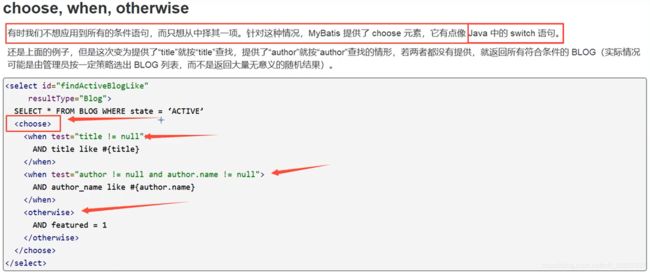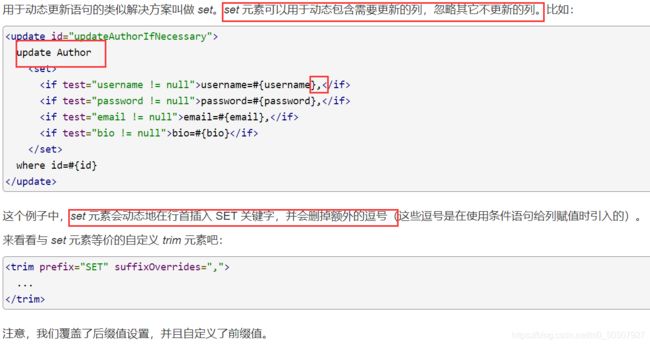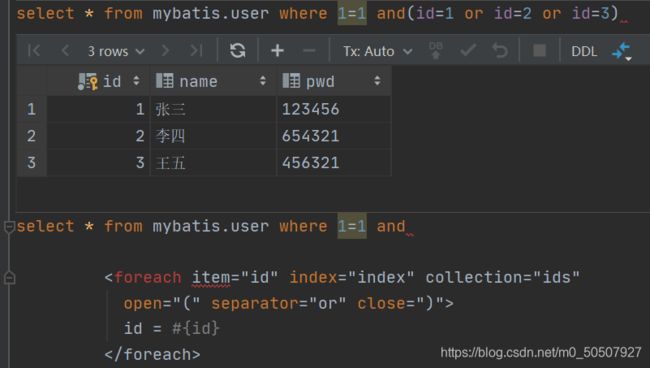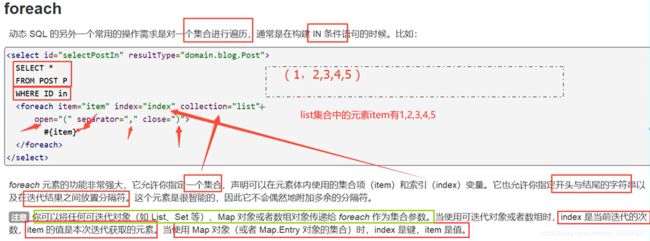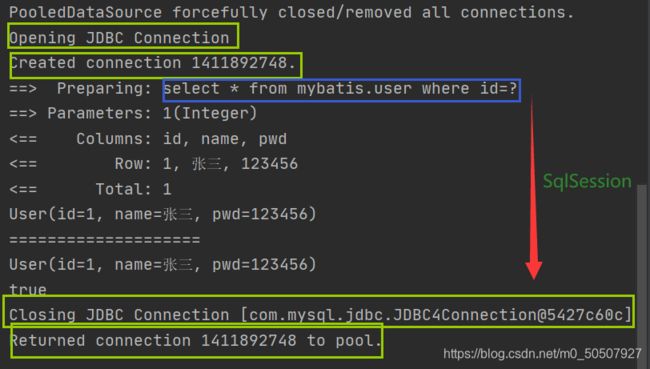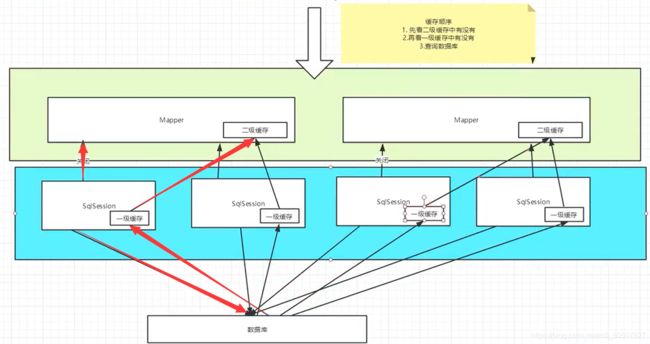Mybatis
目录
- 一,Mybatis简介
-
- 1,什么是Mybatis
-
- 如何获得Mybatis
- 2,持久化
- 3,持久层
- 4,为什么需要MyBatis
- 二,第一个Mybatis程序
-
- 1,搭建环境
- 2,创建一个模块
-
- (1)编写mybatis的核心配置文件
- (2)编写mybatis工具类(获取sqlSessionFactory 对象)
- 3,编写代码
- 4,测试
- 5,可能会遇到的问题
- 三,CRUD
-
- 1,namespace
- 2,select
- 3, Insert
- 4,Update
- 5,Delete
- 6,分析错误
- 四,万能Map
-
- 模糊查询
-
- java代码执行的时候,传递通配符% %
- 在sql拼接中使用通配符
- 五,配置解析
-
- 1,核心配置文件
- 2,环境配置 environments
- 3,属性 properties
- 4,类型别名(typeAliases)
- 5,设置
- 6,其他配置
- 7, 映射器(mappers)
-
- 方式一:使用相对于类路径的资源引用
- 方式二:使用class文件绑定注册
- 方式三:使用包扫描进行注入
- 8,生命周期和作用域
- 六,解决属性名和字段名不一致的问题
-
- 问题
- 解决方法-起别名
- 解决方法-resultMap
- 七,日志
-
- 日志工厂
-
- STDOUT_LOGGING标准日志输出
- Log4j
-
- Log4j简单使用
- 八,分页
-
- 使用Limit分页
-
- 使用MyBatis实现分页,核心SQL
- RowBounds类分页
- MyBatis 分页插件 PageHelper
- 九,使用注解开发
-
- 面向接口编程
-
- 关于接口的理解
- 三个面向区别
- 使用注解开发
- MyBatis详细执行流程
- 注解的CRUD
-
- 关于@Param()注解
- #{} 和 ${}区别:
- 十,Lombok
-
- 使用步骤:
- 十一,多对一处理--对象:association关联
-
- 1,测试环境搭建
-
- 1,导入Lombok
- 2,新建实体类Teacher,Student
- 3,建立实体类的Mapper接口
- 4,建立Mapper.XML文件
- 5,在核心配置文件中绑定注册我们的Mapper接口或者文件!
- 6,测试查询是否能够成功!
- 2,多对一案例:查询所有的学生信息,以及对应的老师的信息(按照查询嵌套处理-子查询)
- 3,多对一案例:查询所有的学生信息,以及对应的老师的信息(按照结果嵌套处理-关联查询)
- 十二,一对多处理--集合:collection
-
- 1,测试环境搭建
- 2,一对多案例:获取指定老师下的所有学生及老师的信息(按照查询嵌套处理-子查询)
- 3,一对多案例:获取指定老师下的所有学生及老师的信息(按照结果嵌套处理-关联查询)
- 小结
-
- 问题
- InnoDB底层原理
- 十三,动态SQL
-
- 1,搭建环境
- 2,IF
- 3,choose (when, otherwise)
- 4,trim (where, set)
-
- trim (where)
- trim (set)
- trim
- 5,SQL片段
- 6,Foreach
- 十四,缓存
-
- 1,简介
- 2,Mybatis缓存
- 3,一级缓存
-
- 缓存失效的情况:
- 4,二级缓存
- 5,缓存原理
- 6,自定义缓存-ehcache
- 十五,gitee项目练习:
一,Mybatis简介
Mybatis中文文档:https://mybatis.org/mybatis-3/zh/index.html
1,什么是Mybatis

MyBatis 是一款优秀的持久层框架;
它支持自定义 SQL、存储过程以及高级映射。
MyBatis 免除了几乎所有的 JDBC 代码以及设置参数和获取结果集的工作。
MyBatis 可以通过简单的 XML 或注解来配置和映射原始类型、接口和 Java POJO(Plain Old Java Objects,普通老式 Java 对象)为数据库中的记录。
MyBatis 本是apache的一个开源项目iBatis,
2010年这个项目由apache software foundation 迁移到了google code,并且改名为MyBatis 。
2013年11月迁移到Github。
如何获得Mybatis
maven仓库:
<!-- https://mvnrepository.com/artifact/org.mybatis/mybatis -->
<dependency>
<groupId>org.mybatis</groupId>
<artifactId>mybatis</artifactId>
<version>3.5.6</version>
</dependency>
中文文档:https://mybatis.org/mybatis-3/zh/index.html
Github: https://github.com/mybatis/mybatis-3
2,持久化
数据持久化
持久化就是将程序的数据在持久状态和瞬时状态转化的过程
内存:断电即失
数据持久化:数据库(Jdbc),io文件持久化。
生活方面:冷藏,罐头。
为什么要持久化?
有一些对象,不能让他丢掉
内存太贵
3,持久层
Dao层、Service层、Controller层
完成持久化工作的代码块
层界限十分明显
4,为什么需要MyBatis
帮助程序员将数据存入到数据库中
方便
传统的JDBC代码太复杂了,简化,框架,自动化
不用MyBatis也可以,技术没有高低之分
优点:
简单易学
灵活
sql和代码的分离,提高了可维护性。
提供映射标签,支持对象与数据库的orm字段关系映射
提供对象关系映射标签,支持对象关系组建维护
提供xml标签,支持编写动态sql
二,第一个Mybatis程序
1,搭建环境
2,删除src目录 (就可以把此工程当做父工程了,然后创建子工程)
3,导入maven依赖
mysql
mysql-connector-java
5.1.47
org.mybatis
mybatis
3.5.6
junit
junit
4.12
2,创建一个模块
(1)编写mybatis的核心配置文件
<?xml version="1.0" encoding="UTF-8" ?>
<!DOCTYPE configuration
PUBLIC "-//mybatis.org//DTD Config 3.0//EN"
"http://mybatis.org/dtd/mybatis-3-config.dtd">
<!--configuration core file-->
<configuration>
<environments default="development">
<environment id="development">
<transactionManager type="JDBC"/>
<dataSource type="POOLED">
<property name="driver" value="com.mysql.jdbc.Driver"/>
<property name="url" value="jdbc:mysql://localhost:3306/mybatis?useSSL=false&useUnicode=true&characterEncoding=UTF-8"/>
<property name="username" value="root"/>
<property name="password" value="123456"/>
</dataSource>
</environment>
</environments>
<!--a Mapper.xml need regist in Mybatis core configuration file-->
<mappers>
<mapper resource="com/wang/dao/UserMapper.xml"/>
</mappers>
</configuration>
(2)编写mybatis工具类(获取sqlSessionFactory 对象)
每个基于 MyBatis 的应用都是以一个 SqlSessionFactory 的实例为核心的。SqlSessionFactory 的实例可以通过 SqlSessionFactoryBuilder 获得。而 SqlSessionFactoryBuilder 则可以从 XML 配置文件或一个预先配置的 Configuration 实例来构建出 SqlSessionFactory 实例。
//sqlSessionFactory --> sqlSession
public class MybatisUtils {
static SqlSessionFactory sqlSessionFactory = null;
static {
try {
//使用Mybatis第一步 :获取sqlSessionFactory对象
String resource = "mybatis-config.xml";
InputStream inputStream = Resources.getResourceAsStream(resource);
sqlSessionFactory = new SqlSessionFactoryBuilder().build(inputStream);
} catch (IOException e) {
e.printStackTrace();
}
}
//既然有了 SqlSessionFactory,顾名思义,我们可以从中获得 SqlSession 的实例。
// SqlSession 提供了在数据库执行 SQL 命令所需的所有方法。你可以通过 SqlSession 实例来直接执行已映射的 SQL 语句。
public static SqlSession getSqlSession(){
return sqlSessionFactory.openSession();
}
}
3,编写代码
1,实体类
package com.wang.pojo;
//实体类
public class User {
private int id;
private String name;
private String pwd;
public User() {
}
public User(int id, String name, String pwd) {
this.id = id;
this.name = name;
this.pwd = pwd;
}
public int getId() {
return id;
}
public void setId(int id) {
this.id = id;
}
public String getName() {
return name;
}
public void setName(String name) {
this.name = name;
}
public String getPwd() {
return pwd;
}
public void setPwd(String pwd) {
this.pwd = pwd;
}
@Override
public String toString() {
return "User{" +
"id=" + id +
", name='" + name + '\'' +
", pwd='" + pwd + '\'' +
'}';
}
}
2,Dao接口
public interface UserDao {
List<User> getUserList();
}
3,接口实现类 由原来的UserDaoImpl转变成一个Mapper配置文件。

<?xml version="1.0" encoding="UTF8" ?>
<!DOCTYPE mapper
PUBLIC "-//mybatis.org//DTD Mapper 3.0//EN"
"http://mybatis.org/dtd/mybatis-3-mapper.dtd">
<!--namespace绑定一个对应的Dao/Mapper接口-->
<mapper namespace="com.wang.dao.UserDao">
<!--sql-->
<select id="getUserList" resultType="com.wang.pojo.User">
select * from mybatis.user
</select>
</mapper>
4,测试
junit测试:
public class UserDaoTest {
@Test
public void test(){
//第一步:获得SqlSession对象
SqlSession sqlSession = MybatisUtils.getSqlSession();
//方式一:getMapper
UserDao userDao = sqlSession.getMapper(UserDao.class);
List<User> userList = userDao.getUserList();
for (User user : userList) {
System.out.println(user);
}
//关闭SqlSession
sqlSession.close();
}
}
5,可能会遇到的问题
1,配置文件没有注册
2,绑定接口错误
3,方法名不对
4,返回类型不对
5,Maven导出资源问题
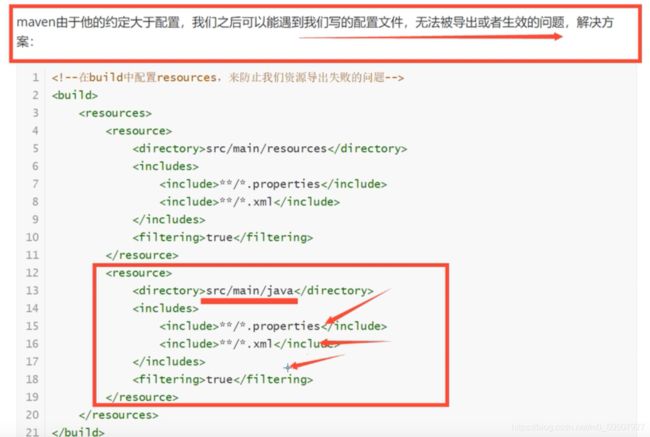
三,CRUD
注意点:
增删改需要提交事务!
1,namespace
namespace中的包名要和Dao/Mapper接口的包名一致
2,select
选择,查询语句;
id:就是对应的namespace中的方法名;
resultType : Sql语句执行的返回值;
parameterType : 参数类型;
(1)编写接口
public interface UserDao {
//查询全部用户
List<User> getUserList();
//根据id查询用户
User getUserById(int id);
}
(2)编写对应的mapper中的sql语句
<?xml version="1.0" encoding="UTF-8" ?>
<!DOCTYPE mapper
PUBLIC "-//mybatis.org//DTD Mapper 3.0//EN"
"http://mybatis.org/dtd/mybatis-3-mapper.dtd">
<mapper namespace="com.wang.dao.UserDao">
<!--sql-->
<select id="getUserList" resultType="com.wang.pojo.User">
select * from mybatis.user
</select>
<select id="getUserById" parameterType="int" resultType="com.wang.pojo.User">
select * from mybatis.user where id=#{id}
</select>
</mapper>
(3)测试
@Test
public void getUserById(){
SqlSession sqlSession = MybatisUtils.getSqlSession();
UserDao mapper = sqlSession.getMapper(UserDao.class);
User user = mapper.getUserById(1);
System.out.println("编号为1的用户:"+user);
//关闭SqlSession
sqlSession.close();
}
3, Insert
//insert一个用户
int addUser(User user);
<!-- 插入语句:对象中的属性,可以直接取出来-->
<select id="addUser" parameterType="com.wang.pojo.User">
insert into mybatis user(id,name,pwd) values(#{id},#{name},#{pwd});
</select>
@Test
public void addUser(){
SqlSession sqlSession=MybatisUtils.getSqlSession();
UserDao userDao = sqlSession.getMapper(UserDao.class);
userDao.addUser(new User(4,"礼拜四","999999"));
sqlSession.commit();//提交事务
sqlSession.close();
}
4,Update
//修改用户
int updateUser(User user);
<update id="updateUser" parameterType="com.wang.pojo.User">
update mybatis.user set name=#{name },pwd=#{pwd} where id=#{id};
</update>
@Test
public void updateUser(){
SqlSession sqlSession=MybatisUtils.getSqlSession();
UserDao userDao = sqlSession.getMapper(UserDao.class);
userDao.updateUser(new User(4,"星期四","808080"));
sqlSession.commit();
sqlSession.close();
}
5,Delete
//删除用户
int deleteUser(int id);
<delete id="deleteUser" parameterType="int">
delete from mybatis.user where id=#{id};
</delete>
@Test
public void deleteUser(){
SqlSession sqlSession=MybatisUtils.getSqlSession();
UserDao userDao=sqlSession.getMapper(UserDao.class);
userDao.deleteUser(4);
sqlSession.commit();
sqlSession.close();
}
6,分析错误
1,namespace绑定一个对应的Dao/Mapper接口
2,com.mysql.jdbc.exceptions.jdbc4.MySQLSyntaxErrorException
书写的sql语句不正常,会导致mysql抛出异常。如:insert 写成 isert 等问题。sql 不符合规范
3,resource绑定mapper,需要使用路径!
报错:
org.apache.ibatis.binding.BindingException: Type interface com.wang.dao.UserMapper is not known to the MapperRegistry.
4,NullPointerException,没有注册到资源!
5,maven资源没有导出问题!
src/main/resources
**/*.properties
**/*.xml
true
src/main/java
**/*.properties
**/*.xml
true
6,It’s likely that neither a Result Type nor a Result Map was specified.
Mybatis,这是因为没有指定好查询语句的返回数据类型导致的,在xml里编写sql语句一定要指定实现函数的参数类型和返回类型。
四,万能Map
假设,我们的实体类,或者数据库中的表,字段或者参数过多,我们应该考虑使用Map!
万能的Mapinsert一个用户
1,编写接口
//万能的map
int addUser2(Map map);
2,编写对应的mapper中的sql语句
//传递map中的key可以为任意值
insert into mybatis.user (id,name,pwd) values (#{userid},#{userName},#{password})
3,测试
@Test
public void addUser2(){
SqlSession sqlSession=MybatisUtils.getSqlSession();
UserDao userDao = sqlSession.getMapper(UserDao.class);
Map map=new HashMap();
map.put("userid",5);
map.put("userName","发");
map.put("password","888888");
userDao.addUser2(map);
sqlSession.commit();//提交事务
sqlSession.close();
}
万能Map查询用户
1,编写接口
User getUserById2(Map map);
2,编写对应的mapper中的sql语句
3,测试
@Test
public void getUserById2() {
SqlSession sqlSession = MybatisUtils.getSqlSession();
UserDao mapper = sqlSession.getMapper(UserDao.class);
Map map=new HashMap();
map.put("id",1);
map.put("name","张三");
User user=mapper.getUserById2(map);
System.out.println("编号为1的用户:" + user);
//关闭SqlSession
sqlSession.close();
}
Map传递参数,直接在sql中取出key即可! 【parameter=“map”】
对象传递参数,直接在sql中取出对象的属性即可! 【parameter=“Object”】
只有一个基本类型参数的情况下,可以直接在sql中取到
多个参数用Map , 或者注解!
模糊查询
模糊查询怎么写?
java代码执行的时候,传递通配符% %
1,编写接口
List getUserLike(String value);
2,编写对应的mapper中的sql语句
3,测试
@Test
public void getUserLike() {
SqlSession sqlSession = MybatisUtils.getSqlSession();
UserDao mapper = sqlSession.getMapper(UserDao.class);
List userList = mapper.getUserLike("%李%");
for (User user : userList) {
System.out.println(user);
}
//关闭SqlSession
sqlSession.close();
}
在sql拼接中使用通配符
<select id="getUserLike" resultType="com.wang.pojo.User" >
select * from mybatis.user user where name like "%"#{value}"%"
</select>
五,配置解析
1,核心配置文件
mybatis-config.xml
Mybatis的配置文件包含了会深深影响MyBatis行为的设置和属性信息。
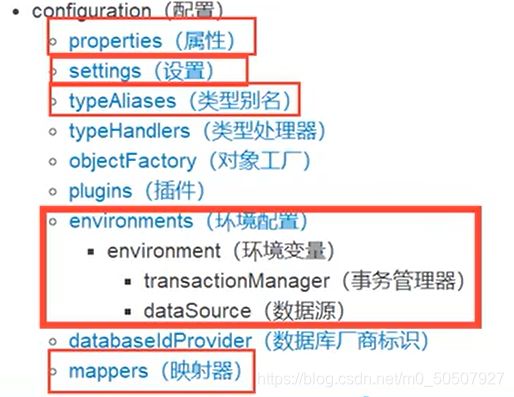
2,环境配置 environments
MyBatis 可以配置成适应多种环境
不过要记住:尽管可以配置多个环境,但每个 SqlSessionFactory 实例只能选择一种环境
transactionManager :
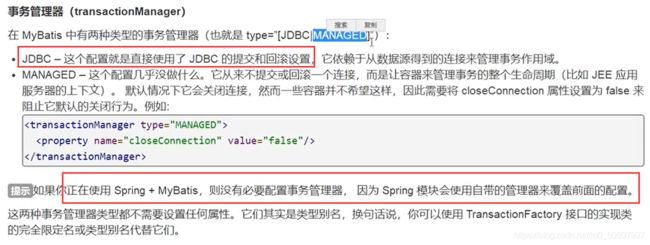
数据源dataSource:
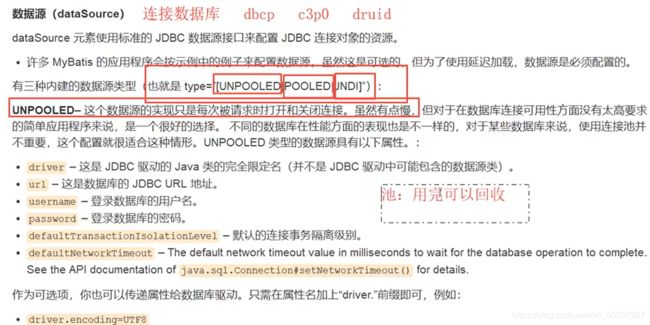
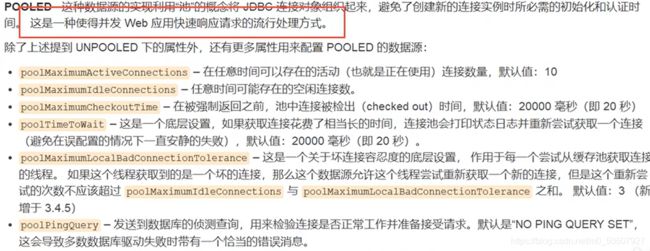
MyBatis默认的事务管理器就是JDBC ,连接池:POOLED
3,属性 properties
我们可以通过properties属性来实现引用配置文件
这些属性可以在外部进行配置,并可以进行动态替换。你既可以在典型的 Java 属性文件中配置这些属性,也可以在 properties 元素的子元素中设置。【db.poperties】
把项目改造成可插入的:
1,编写一个配置文件 db.properties
driver=com.mysql.jdbc.Driver
url=jdbc:mysql://localhost:3306/mybatis?useSSL=false&useUnicode=true&characterEncoding=UTF-8
username=root
password=123456
2,在核心配置文件中引入
总结:
可以直接引入外部文件
可以在其中增加一些属性配置
如果两个文件有同一个字段,优先使用外部配置文件的
4,类型别名(typeAliases)
类型别名是为Java类型设置一个短的名字。 它仅用于 XML 配置.
意在降低冗余的全限定类名书写。
1,User可以用在任何使用com.wang.pojo.User的地方。
2,也可以指定一个包名,MyBatis会在包名下面搜索需要的JavaBean,比如:
扫描实体类的包,它的默认别名就为这个类的类名,首字母小写!
在实体类比较少的时候,使用第一种方式。
如果实体类十分多,建议使用第二种。
第一种可以自定义别名,第二种则不行,如果非要改,需要在实体上增加注解:
//实体类
@Alias("hello")
public class User {}
<!--sql-->
<select id="getUserList" resultType="hello">
select * from mybatis.user
</select>
下面是一些为常见的 Java 类型内建的类型别名。它们都是不区分大小写的,注意,为了应对原始类型的命名重复,采取了特殊的命名风格。
别名 映射的类型
| 别名 | 映射的类型 |
|---|---|
| _byte | byte |
| _long | long |
| _short | short |
| _int | int |
| _integer | int |
| _double | double |
| _float | float |
| _boolean | boolean |
| string | String |
| byte | Byte |
| long | Long |
| short | Short |
| int | Integer |
| integer | Integer |
| double | Double |
| float | Float |
| boolean | Boolean |
| date | Date |
| decimal | BigDecimal |
| bigdecimal | BigDecimal |
| object | Object |
| map | Map |
| hashmap | HashMap |
| list | List |
| arraylist | ArrayList |
| collection | Collection |
| iterator | Iterator |
5,设置
这是 MyBatis 中极为重要的调整设置,它们会改变 MyBatis 的运行时行为。

![]()
打印日志:

一个配置完整的 settings 元素的示例如下:
<settings>
<setting name="cacheEnabled" value="true"/>
<setting name="lazyLoadingEnabled" value="true"/>
<setting name="multipleResultSetsEnabled" value="true"/>
<setting name="useColumnLabel" value="true"/>
<setting name="useGeneratedKeys" value="false"/>
<setting name="autoMappingBehavior" value="PARTIAL"/>
<setting name="autoMappingUnknownColumnBehavior" value="WARNING"/>
<setting name="defaultExecutorType" value="SIMPLE"/>
<setting name="defaultStatementTimeout" value="25"/>
<setting name="defaultFetchSize" value="100"/>
<setting name="safeRowBoundsEnabled" value="false"/>
<setting name="mapUnderscoreToCamelCase" value="false"/>
<setting name="localCacheScope" value="SESSION"/>
<setting name="jdbcTypeForNull" value="OTHER"/>
<setting name="lazyLoadTriggerMethods" value="equals,clone,hashCode,toString"/>
</settings>
6,其他配置
typeHandlers(类型处理器):
https://mybatis.org/mybatis-3/zh/configuration.html#typeHandlers
objectFactory(对象工厂):
https://mybatis.org/mybatis-3/zh/configuration.html#objectFactory
plugins(插件)
https://mvnrepository.com/search?q=mybatis
1,mybatis-generator-core
2,mybatis-plus
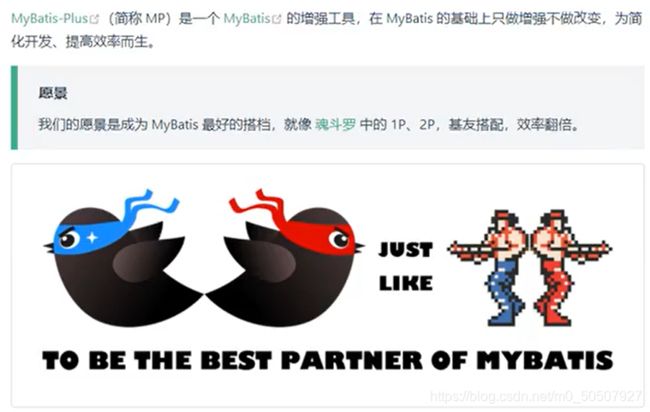
3,通用mapper
7, 映射器(mappers)
MapperRegistry:注册绑定我们的Mapper文件;
方式一:使用相对于类路径的资源引用
方式二:使用class文件绑定注册
方式三:使用包扫描进行注入
方式二与方式三:
报错:org.apache.ibatis.binding.BindingException: Invalid bound statement (not found): com.wang.dao.UserDao.getUserList
注意点:
接口和它的Mapper配置文件必须同名!
接口和它的Mapper配置文件必须在同一个包下!
8,生命周期和作用域
声明周期和作用域是至关重要的,因为错误的使用会导致非常严重的并发问题。
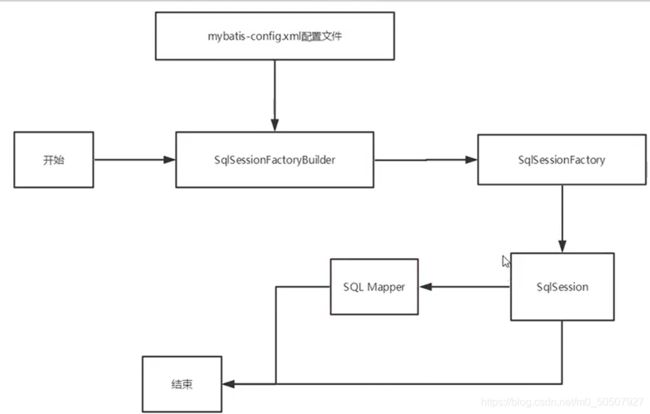
SqlSessionFactoryBuilder:
一旦创建了SqlSessionFactory,就不再需要它了
局部变量
SqlSessionFactory:
说白了就可以想象为:数据库连接池
SqlSessionFactory一旦被创建就应该在应用的运行期间一直存在,没有任何理由丢弃它或重新创建一个实例。
因此SqlSessionFactory的最佳作用域是应用作用域(ApplocationContext)。
最简单的就是使用单例模式或静态单例模式。
SqlSession:
连接到连接池的一个请求
SqlSession 的实例不是线程安全的,因此是不能被共享的,所以它的最佳的作用域是请求或方法作用域。
用完之后需要赶紧关闭,否则资源被占用!

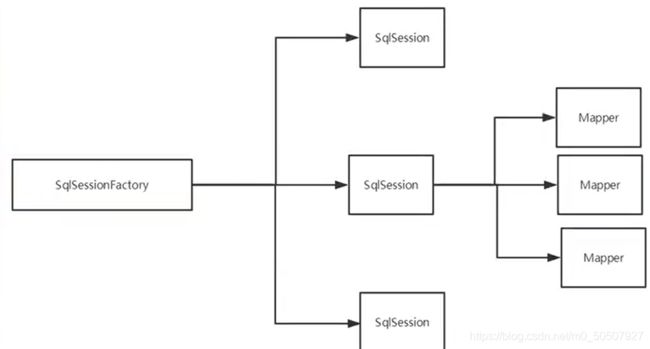
这里的每一个Mapper,就代表一个具体的业务(CRUD)!
@Test
public void test() {
//第一步:获得SqlSession对象
SqlSession sqlSession = MybatisUtils.getSqlSession();
//方式一:getMapper
UserMapper mapper = sqlSession.getMapper(UserMapper.class);
List userList = mapper.getUserList();
for (User user : userList) {
System.out.println(user);
}
//关闭SqlSession
sqlSession.close();
}
六,解决属性名和字段名不一致的问题
问题
//实体类
public class User {
private int id;
private String name;
private String password;
// select * from user where id = #{id}
// 类型处理器
// select id,name,pwd from user where id = #{id}
解决方法-起别名
<!--sql-->
<select id="getUserList" resultType="User">
select id,name,pwd as password from mybatis.user
</select>
解决方法-resultMap
结果集映射
id name pwd
id name password
实现:
<!--结果集映射-->
<resultMap id="UserMap" type="User">
<!--column数据库中的字段,property实体类中的属性-->
<result column="id" property="id"/>
<result column="name" property="name"/>
<result column="pwd" property="password"/>
</resultMap>
<!--sql-->
<select id="getUserList" resultMap="UserMap">
select * from mybatis.user
</select>
resultMap 元素是 MyBatis 中最重要最强大的元素。
ResultMap 的设计思想是,对简单的语句做到零配置,对于复杂一点的语句,只需要描述语句之间的关系就行了。
ResultMap 的优秀之处——你完全可以不用显式地配置它们。
七,日志
日志工厂
如果一个数据库操作,出现了异常,我们需要排错,日志就是最好的助手!
曾经:sout、debug
SLF4J
LOG4J 【掌握】
LOG4J2
JDK_LOGGING(java自带的日志输出)
COMMONS_LOGGING(工具包)
STDOUT_LOGGING 【控制台输出】
NO_LOGGING(没有日志输出)
在MyBatis中具体使用哪一个日志实现,在设置中设定
STDOUT_LOGGING标准日志输出
在mybatis-config.xml核心配置文件中,配置我们的日志!
标准日志工厂实现:
Log4j
什么是Log4j?
Log4j是Apache的一个开源项目,通过使用Log4j,我们可以控制日志信息输送的目的地是控制台还是文件、GUI组件
我们也可以控制每一条日志的输出格式;
通过定义每一条日志信息的级别,我们能够更加细致地控制日志的生成过程。
可以通过一个配置文件来灵活地进行配置,而不需要修改应用的代码。
1.先在pom.xml文件中导入log4j的依赖包
log4j
log4j
1.2.17
2.在resources文件夹下建立log4j.properties文件进行配置
#将等级为DEBUG的日志信息输出到console和file这两个目的地,console和file的定义在下面的代码
log4j.rootLogger=DEBUG,console,file
#控制台输出的相关设置
log4j.appender.console = org.apache.log4j.ConsoleAppender
log4j.appender.console.Target = System.out
log4j.appender.console.Threshold=DEBUG
log4j.appender.console.layout = org.apache.log4j.PatternLayout
log4j.appender.console.layout.ConversionPattern=[%c]-%m%n
#文件输出的相关设置
log4j.appender.file = org.apache.log4j.RollingFileAppender
log4j.appender.file.File=./log/rzp.log
log4j.appender.file.MaxFileSize=10mb
log4j.appender.file.Threshold=DEBUG
log4j.appender.file.layout=org.apache.log4j.PatternLayout
log4j.appender.file.layout.ConversionPattern=[%p][%d{yy-MM-dd}][%c]%m%n
#日志输出级别
log4j.logger.org.mybatis=DEBUG
log4j.logger.java.sql=DEBUG
log4j.logger.java.sql.Statement=DEBUG
log4j.logger.java.sql.ResultSet=DEBUG
log4j.logger.java.sq1.PreparedStatement=DEBUG
3.在mybatis-config.xml核心配置文件中,配置log4j为日志的实现!
4.Log4j的使用,直接测试运行
Log4j简单使用
1,在要使用Log4j的测试类中,导入包import org.apache.log4j.Logger;
2,日志对象,参数为当前类的class
static Logger logger = Logger.getLogger(UserDaoTest.class);
3,日志级别
@Test
public void testLog4j(){
logger.info("info:进入了testLog4j");
logger.debug("DEBUG:进入了testLog4j");
logger.error("erro:进入了testLog4j");
}
八,分页
思考:为什么分页?
减少数据的处理量
使用Limit分页
语法:SELECT * from user limit startIndex,pageSize
SELECT * from user limit 3 #[0,n]
使用MyBatis实现分页,核心SQL
1,接口
//分页
List getUserByLimit(Map map);
2,Mapper.xml
错误:
Result Maps collection does not contain value for com.wang.dao.UserMapper.user
3,测试
@Test
public void getUserByLimit(){
SqlSession sqlSession=MybatisUtils.getSqlSession();
UserMapper mapper=sqlSession.getMapper(UserMapper.class);
Map map=new HashMap();
map.put("startIndex",0);
map.put("pageSize",3);
List userList = mapper.getUserByLimit(map);
for (User user : userList) {
System.out.println(user);
}
sqlSession.close();
}
RowBounds类分页
不再使用SQL实现分页
1,接口
//分页2
List getUserByRowBounds();
2,Mapper.xml
3,测试
@Test
public void getUserByRowBounds(){
SqlSession sqlSession = MybatisUtils.getSqlSession();
//RowBounds实现分页
RowBounds rowBounds = new RowBounds(0, 2);
//通过java代码层面实现分页
List userList = sqlSession.selectList("com.wang.dao.UserMapper.getUserByRowBounds",null,rowBounds);
for (User user : userList) {
System.out.println(user);
}
sqlSession.close();
}
MyBatis 分页插件 PageHelper
https://pagehelper.github.io/
如何使用分页插件:
https://pagehelper.github.io/docs/howtouse/
九,使用注解开发
面向接口编程
之前学过面向对象编程,也学习过接口,但在真正的开发中,很多时候会选择面向接口编程。
根本原因:解耦,可拓展,提高复用,分层开发中,上层不用管具体的实现,大家都遵守共同的标准,使得开发变得容易,规范性更好
在一个面向对象的系统中,系统的各种功能是由许许多多的不同对象协作完成的。在这种情况下,各个对象内部是如何实现自己的,对系统设计人员来讲就不那么重要了;
而各个对象之间的协作关系则成为系统设计的关键。小到不同类之间的通信,大到各模块之间的交互,在系统设计之初都是要着重考虑的,这也是系统设计的主要工作内容。面向接口编程就是指按照这种思想来编程。
关于接口的理解
三个面向区别
面向对象是指,我们考虑问题时,以对象为单位,考虑它的属性和方法;
面向过程是指,我们考虑问题时,以一个具体的流程(事务过程)为单位,考虑它的实现;
接口设计与非接口设计是针对复用技术而言的,与面向对象(过程)不是一个问题,更多的体现就是对系统整体的架构;
使用注解开发

1,注解在UserMapper接口上实现,并删除UserMapper.xml文件
@Select("select * from user")
List getUsers();
2,需要在mybatis-config.xml核心配置文件中绑定接口
3,测试
@Test
public void test(){
SqlSession sqlSession= MybatisUtils.getSqlSession();
//底层主要用到反射
UserMapper mapper=sqlSession.getMapper(UserMapper.class);
List users=mapper.getUsers();
for (User user : users) {
System.out.println(user);
}
sqlSession.close();
}
本质:反射机制实现
底层:动态代理
MyBatis详细执行流程

1,通过Resources对象获取全局配置文件

2,实例化SqlSessionFactoryBuilder构造器
sqlSessionFactory = new SqlSessionFactoryBuilder().build(inputStream);
3,通过XMLConfigBuilder解析配置文件流
4,Configuration所有的配置信息
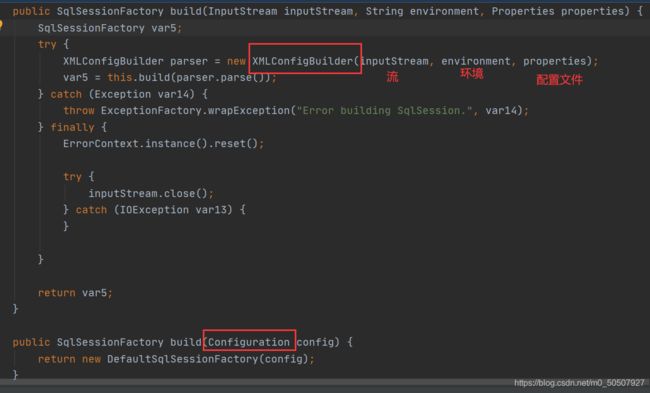
5,sqlSessionFactory实例化
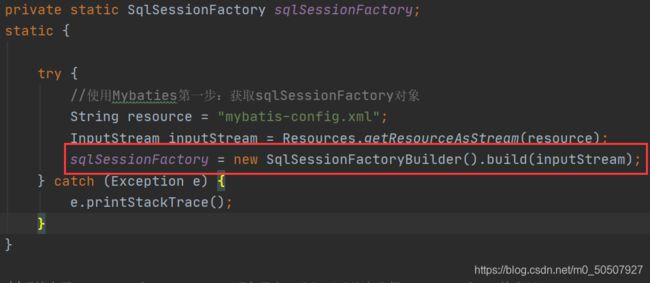
6,transactional事务管理
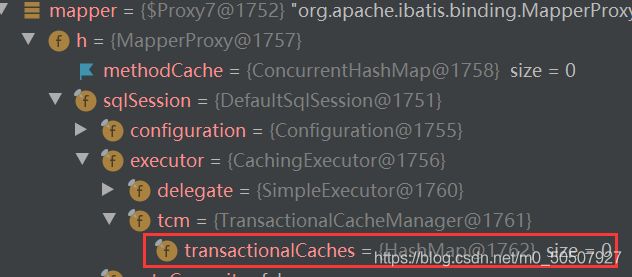
7,创建executor执行器—Mybatis最核心的对象
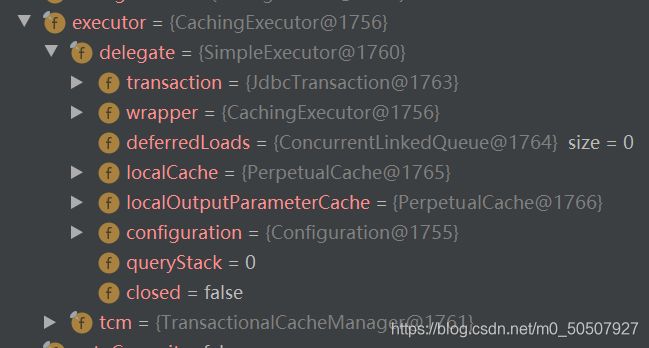
8,创建sqlSession

9,实现CRUD,事务出现问题,回滚
10,查看是否执行成功,不成功,回滚
11,成功,提交事务
注解的CRUD
1,在MybatisUtils工具类创建的时候实现自动提交事务!

//既然有了 SqlSessionFactory,顾名思义,我们可以从中获得 SqlSession 的实例。
// SqlSession 提供了在数据库执行 SQL 命令所需的所有方法。你可以通过 SqlSession 实例来直接执行已映射的 SQL 语句。
public static SqlSession getSqlSession(){
// SqlSession sqlSession = sqlSessionFactory.openSession();
// return sqlSession;
return sqlSessionFactory.openSession(true);
}
2,编写接口,增加注解
//方法存在多个参数,所有参数前面必须加上@Param("id")注解
@Select("select * from user where id=#{id}")
User getUserById(@Param("id") int id);
3,测试类
@Test
public void test(){
SqlSession sqlSession= MybatisUtils.getSqlSession();
//底层主要用到反射
UserMapper mapper=sqlSession.getMapper(UserMapper.class);
// List users=mapper.getUsers();
// for (User user : users) {
// System.out.println(user);
// }
User userById = mapper.getUserById(1);
System.out.println(userById);
sqlSession.close();
}
public interface UserMapper {
@Select("select * from user")
List getUsers();
//方法存在多个参数,所有参数前面必须加上@Param("id")注解
@Select("select * from user where id=#{id}")
User getUserById(@Param("id") int id);
@Insert("insert into user (id,name,pwd) values(#{id},#{name},#{password})")
int addUser(User user);
@Update("update user set name=#{name},pwd=#{password} where id=#{id}")
int updateUser(User user);
@Delete("delete from user where id = #{uid}")
int deleteUser(@Param("uid") int id);
}
测试:
public class UserMapperTest {
@Test
public void test(){
SqlSession sqlSession= MybatisUtils.getSqlSession();
//底层主要用到反射
UserMapper mapper=sqlSession.getMapper(UserMapper.class);
// List users=mapper.getUsers();
// for (User user : users) {
// System.out.println(user);
// }
/*查询
User userById = mapper.getUserById(1);
System.out.println(userById);
*/
/*添加
mapper.addUser(new User(7,"政法学教授","1314007"));
*/
/*更新
mapper.updateUser(new User(7,"张三","1314007"));
*/
mapper.deleteUser(7);//删除
sqlSession.close();
}
}
注意:我们必须要将接口注册绑定到我们的核心配置文件中!
关于@Param()注解
基本类型的参数或者String类型,需要加上
引用类型不需要加
如果只有一个基本类型的话,可以忽略,但是建议大家都加上
我们在SQL中引用的就是我们这里的@Param()中设定的属性名
#{} 和 ${}区别:
#{} 这种取值是编译好SQL语句再取值
${} 这种是取值以后再去编译SQL语句
#{}方式能够很大程度防止sql注入。
$方式无法防止Sql注入。
$方式一般用于传入数据库对象,例如传入表名.
举例:
sql语句:
delete from
ups_role_permission_dataparams
where role_id = #{roleId,jdbcType=INTEGER}
在这里用到了#{},使用#时:
1、用来传入参数,sql在解析的时候会加上" ",当成字符串来解析 ,如这里 role_id = “roleid”;
2、#{}能够很大程度上防止sql注入;
1、用${}传入数据直接显示在生成的sql中,如上面的语句,用role_id = ${roleId,jdbcType=INTEGER},那么sql在解析的时候值为role_id = roleid,执行时会报错;
2、${}方式无法防止sql注入;
3、$一般用入传入数据库对象,比如数据库表名;
注意:
mybaties排序时使用order by 动态参数时需要注意,使用${}而不用#{};
4、能用#{}时尽量用#{};
十,Lombok
Lombok: 自动插入编辑器并构建工具,以注解的方式,简化一些模版代码的编写,
如getter/setter方法
Lombok项目是一个Java库,它会自动插入编辑器和构建工具中,Lombok提供了一组有用的注释,用来消除Java类中的大量样板代码。仅五个字符(@Data)就可以替换数百行代码从而产生干净,简洁且易于维护的Java类。
使用步骤:
1,在IDEA中安装Lombok插件!
2,在项目pom.xml文件中导入Lombok的jar包
org.projectlombok
lombok
1.18.10
3,在实体类上加注解即可!
@Data:无参构造、get、set、toString、hashCode、equals
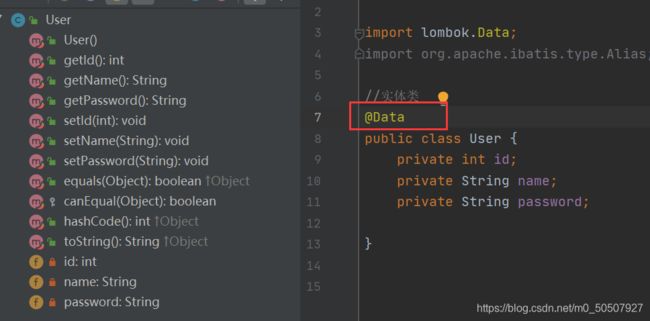
@AllArgsConstructor 有参构造
@NoArgsConstructor 无参构造
@EqualsAndHashCode
@ToString
@Getter and @Setter
十一,多对一处理–对象:association关联
复杂的属性,我们需要单独处理 对象:association 集合:collection

多个学生,对应一个老师
对于学生而言,关联–-------多个学生,关联一个老师【多对一】
对于老师而言,集合--------一个老师,有很多个学生【一对多】
CREATE TABLE `teacher` (
`id` INT(10) NOT NULL,
`name` VARCHAR(30) DEFAULT NULL,
PRIMARY KEY (`id`)
)ENGINE = INNODB DEFAULT CHARSET=utf8;
INSERT INTO teacher(`id`,`name`) VALUES (1,'张三老师');
CREATE TABLE `student` (
`id` INT(10) NOT NULL,
`name` VARCHAR(30) DEFAULT NULL,
`tid` INT(10) DEFAULT NULL,
PRIMARY KEY (`id`),
KEY `fktid`(`tid`),
CONSTRAINT `fktid` FOREIGN KEY (`tid`) REFERENCES `teacher` (`id`)
)ENGINE = INNODB DEFAULT CHARSET=utf8
INSERT INTO `student`(`id`,`name`,`tid`) VALUES ('1','小明','1');
INSERT INTO `student`(`id`,`name`,`tid`) VALUES ('2','小红','1');
INSERT INTO `student`(`id`,`name`,`tid`) VALUES ('3','小张','1');
INSERT INTO `student`(`id`,`name`,`tid`) VALUES ('4','小李','1');
INSERT INTO `student`(`id`,`name`,`tid`) VALUES ('5','小王','1');
1,测试环境搭建
1,导入Lombok
org.projectlombok
lombok
1.18.10
2,新建实体类Teacher,Student
@Data
public class Teacher {
private int id;
private String name;
}
@Data
public class Student {
private int id;
private String name;
//学生需要关联一个老师
private Teacher teacher;
}
3,建立实体类的Mapper接口
public interface TeacherMapper {
}
public interface StudentMapper {
}
4,建立Mapper.XML文件
5,在核心配置文件中绑定注册我们的Mapper接口或者文件!
6,测试查询是否能够成功!
public interface TeacherMapper {
@Select(“select * from teacher where id=#{tid}”)
Teacher getTeacher(@Param(“tid”) int id);
}
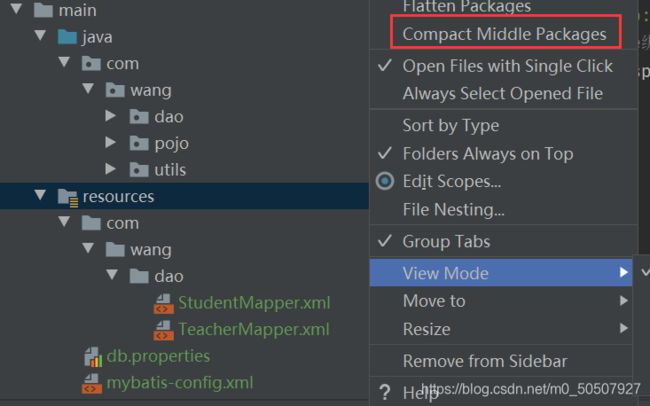
public class MyTest {
public static void main(String[] args) {
SqlSession sqlSession= MybatisUtils.getSqlSession();
TeacherMapper mapper = sqlSession.getMapper(TeacherMapper.class);
Teacher teacher = mapper.getTeacher(1);
System.out.println(teacher);
sqlSession.close();
}
}
回顾Mysql多对一查询方式:
子查询 按照查询嵌套处理
联表查询 按照结果嵌套处理
2,多对一案例:查询所有的学生信息,以及对应的老师的信息(按照查询嵌套处理-子查询)
public interface StudentMapper {
//查询所有的学生信息,以及对应的老师的信息
public List getStudent();
}
<!--按照查询嵌套处理(子查询)-->
<!--思路:
1,查询所有的学生信息
2,根据查询出来的学生的tid,寻找对应的老师-->
<select id="getStudent" resultMap="StudentTeacher">
select * from mybatis.student
</select>
<resultMap id="StudentTeacher" type="Student">
<result property="id" column="id"/>
<result property="name" column="name"/>
<!--复杂的属性,我们需要单独处理 对象:association 集合:collection-->
<association property="teacher" column="tid" javaType="Teacher"
select="getTeacher">
</association>
</resultMap>
<select id="getTeacher" resultType="Teacher">
select * from mybatis.teacher where id=#{tid}
</select>
![]()
测试类:
@Test
public void StudentTest(){
SqlSession sqlSession=MybatisUtils.getSqlSession();
StudentMapper mapper=sqlSession.getMapper(StudentMapper.class);
List studentList=mapper.getStudent();
for (Student student : studentList) {
System.out.println(student);
}
sqlSession.close();
}
3,多对一案例:查询所有的学生信息,以及对应的老师的信息(按照结果嵌套处理-关联查询)
public interface StudentMapper {
//查询所有的学生信息,以及对应的老师的信息
public List getStudent2();
}
<!--按照结果嵌套处理(关联查询)-->
<select id="getStudent2" resultMap="StudentTeacher2">
select s.id sid,s.name sname,t.name tname
from mybatis.student s,mybatis.teacher t
where s.tid = t.id
</select>
<resultMap id="StudentTeacher2" type="Student">
<result property="id" column="sid"/>
<result property="name" column="sname"/>
<association property="teacher" javaType="Teacher">
<result property="name" column="tname"/>
</association>
</resultMap>
@Test
public void StudentTest(){
SqlSession sqlSession=MybatisUtils.getSqlSession();
StudentMapper mapper=sqlSession.getMapper(StudentMapper.class);
List studentList=mapper.getStudent2();
for (Student student : studentList) {
System.out.println(student);
}
sqlSession.close();
}
十二,一对多处理–集合:collection
比如:一个老师拥有多个学生!
对于老师而言,就是一对多的关系!
1,测试环境搭建
{如上}
实体类:
@Data
public class Student {
private int id;
private String name;
private int tid;//学生是个单纯的个体
}
@Data
public class Teacher {
private int id;
private String name;
//一个老师拥有多个学生
private List students;
}
2,一对多案例:获取指定老师下的所有学生及老师的信息(按照查询嵌套处理-子查询)
查询两个语句查,再通过子查询再查一遍
public interface TeacherMapper {
//获取老师
// List getTeacher();
//获取指定老师下的所有学生及老师的信息
Teacher getTeacher(@Param("tid") int id);
Teacher getTeacher2(@Param("tid") int id);
}
<!--按照查询嵌套处理-->
<select id="getTeacher2" resultMap="TeacherStudent2">
select * from mybatis.teacher where id = #{tid}
</select>
<resultMap id="TeacherStudent2" type="Teacher">
<collection property="students" javaType="ArrayList" ofType="Student" select="getStudentByTeacherId" column="id"/>
</resultMap>
<select id="getStudentByTeacherId" resultType="Student">
select * from mybatis.student where tid = #{tid}
</select>
测试:
@Test
public void test(){
SqlSession sqlSession=MybatisUtils.getSqlSession();
TeacherMapper mapper=sqlSession.getMapper(TeacherMapper.class);
Teacher teacherList=mapper.getTeacher2(1);
System.out.println(teacherList);
/*
Teacher(id=0,
name=张三老师,
students=[Student(id=1, name=小明, tid=1),
Student(id=2, name=小红, tid=1),
Student(id=3, name=小张, tid=1),
Student(id=4, name=小李, tid=1),
Student(id=5, name=小王, tid=1)])
*/
sqlSession.close();
}
3,一对多案例:获取指定老师下的所有学生及老师的信息(按照结果嵌套处理-关联查询)
通过结果去做映射
public interface TeacherMapper {
//获取老师
// List getTeacher();
//获取指定老师下的所有学生及老师的信息
Teacher getTeacher(@Param("tid") int id);
}
<!-- 按结果嵌套查询-->
<select id="getTeacher" resultMap="TeacherStudent">
SELECT s.id sid,s.name sname,t.name tname,t.id,tid
from student s,teacher t
where s.tid = t.id and t.id = #{tid}
</select>
<resultMap id="TeacherStudent" type="Teacher">
<result property="id" column="tid"/>
<result property="name" column="tname"/>
<!-- 复杂的属性,我们需要单独处理 对象:association 集合:collection
javaType="" 指定属性的类型!
集合中的泛型信息,我们使用ofType获取
-->
<collection property="students" ofType="Student">
<result property="id" column="sid"/>
<result property="name" column="sname"/>
<result property="tid" column="tid"/>
</collection>
</resultMap>
测试:
@Test
public void test(){
SqlSession sqlSession=MybatisUtils.getSqlSession();
TeacherMapper mapper=sqlSession.getMapper(TeacherMapper.class);
Teacher teacherList=mapper.getTeacher(1);
System.out.println(teacherList);
/*
Teacher(id=1,
name=张三老师,
students=[Student(id=1, name=小明, tid=1),
Student(id=2, name=小红, tid=1),
Student(id=3, name=小张, tid=1),
Student(id=4, name=小李, tid=1),
Student(id=5, name=小王, tid=1)])
*/
sqlSession.close();
}
小结
1.关联-association【多对一】
2,集合-collection【一对多】
3.javaType & ofType
(1)javaType 用来指定实体类中属性的类型
(2)ofType 用来指定映射到List或者集合中的pojo类型,泛型中的约束类型!
注意点:
保证SQL的可读性,尽量保证通俗易懂
注意一对多和多对一中,属性名和字段的问题!
如果问题不好排查错误,可以使用日志,建议使用Log4j
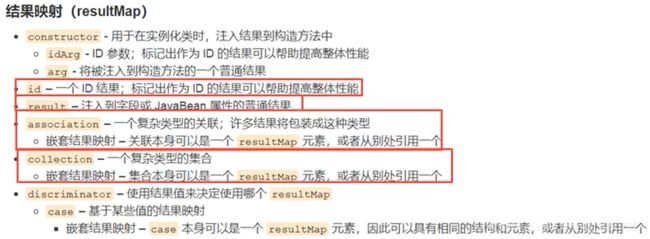
问题
https://blog.csdn.net/m0_50507927/article/details/115951518?spm=1001.2014.3001.5501
Mysql引擎 十五,存储引擎
索引 十七,索引
索引优化 十七,索引 3,索引的失效
索引优化规则:
如果MySQL估计使用索引比全表扫描还慢,则不会使用索引。
返回数据的比例是重要的指标,比例越低越容易命中索引。记住这个范围值——30%,后面所讲的内容都是建立在返回数据的比例在30%以内的基础上。
通过SHOW STATUS LIKE ‘Handler_read%’;查看索引的使用情况:
Handler_read_key:如果索引正在工作,Handler_read_key的值将很高。
Handler_read_rnd_next:数据文件中读取下一行的请求数,如果正在进行大量的表扫描,值将较高
a. 更新十分频繁的字段上不宜建立索引:因为更新操作会变更B+树,重建索引。这个过程是十分消耗数据库性能的。
b. 区分度不大的字段上不宜建立索引:类似于性别这种区分度不大的字段,建立索引的意义不大。因为不能有效过滤数据,性能和全表扫描相当。另外返回数据的比例在30%以外的情况下,优化器不会选择使用索引。
c. 业务上具有唯一特性的字段,即使是多个字段的组合,也必须建成唯一索引。虽然唯一索引会影响insert速度,但是对于查询的速度提升是非常明显的。另外,即使在应用层做了非常完善的校验控制,只要没有唯一索引,在并发的情况下,依然有脏数据产生。
d. 多表关联时,要保证关联字段上一定有索引。
e. 创建索引时避免以下错误观念:索引越多越好,认为一个查询就需要建一个索引;宁缺勿滥,认为索引会消耗空间、严重拖慢更新和新增速度;抵制唯一索引,认为业务的唯一性一律需要在应用层通过“先查后插”方式解决;过早优化,在不了解系统的情况下就开始优化。
InnoDB底层原理
https://zhuanlan.zhihu.com/p/164737611
十三,动态SQL
所谓的动态SQL,本质还是SQL语句,只是我们可以在SQL层面,去执行一个逻辑代码
什么是动态SQL:动态SQL就是 指根据不同的条件生成不同的SQL语句
动态 SQL 是 MyBatis 的强大特性之一。如果你使用过 JDBC 或其它类似的框架,你应该能理解根据不同条件拼接 SQL 语句有多痛苦,例如拼接时要确保不能忘记添加必要的空格,还要注意去掉列表最后一个列名的逗号。利用动态 SQL,可以彻底摆脱这种痛苦。
在 MyBatis 之前的版本中,需要花时间了解大量的元素。借助功能强大的基于 OGNL 的表达式,MyBatis 3 替换了之前的大部分元素,大大精简了元素种类,现在要学习的元素种类比原来的一半还要少。
if
choose (when, otherwise)
trim (where, set)
foreach
1,搭建环境
blog表:
CREATE TABLE `blog`(
`id` VARCHAR(50) NOT NULL COMMENT '博客id',
`title` VARCHAR(100) NOT NULL COMMENT '博客标题',
`author` VARCHAR(30) NOT NULL COMMENT '博客作者',
`create_time` DATETIME NOT NULL COMMENT '创建时间',
`views` INT(30) NOT NULL COMMENT '浏览量'
)ENGINE=INNODB DEFAULT CHARSET=utf8
<dependencies>
<!-- https://mvnrepository.com/artifact/org.projectlombok/lombok -->
<dependency>
<groupId>org.projectlombok</groupId>
<artifactId>lombok</artifactId>
<version>1.18.10</version>
</dependency>
</dependencies>
2,编写配置文件
db.properties
driver=com.mysql.jdbc.Driver
url=jdbc:mysql://localhost:3306/mybatis?useSSL=false&useUnicode=true&characterEncoding=UTF-8
username=root
password=123456
mybatis-config.xml
MybatisUtils
//SqlSessionFactory -->SqlSession
public class MybatisUtils {
private static SqlSessionFactory sqlSessionFactory;
static {
try {
//使用Mybaties第一步:获取sqlSessionFactory对象
String resource = "mybatis-config.xml";
InputStream inputStream = Resources.getResourceAsStream(resource);
sqlSessionFactory = new SqlSessionFactoryBuilder().build(inputStream);
} catch (Exception e) {
e.printStackTrace();
}
}
//既然有了 SqlSessionFactory,顾名思义,我们可以从中获得 SqlSession 的实例。
// SqlSession 提供了在数据库执行 SQL 命令所需的所有方法。你可以通过 SqlSession 实例来直接执行已映射的 SQL 语句。
public static SqlSession getSqlSession(){
// SqlSession sqlSession = sqlSessionFactory.openSession();
// return sqlSession;
return sqlSessionFactory.openSession(true);
}
}
<settings>
<setting name="logImpl" value="STDOUT_LOGGING"/>
<!--开启驼峰命名转换-->
<setting name="mapUnderscoreToCamelCase" value="true"/>
</settings>
@Data
public class Blog {
private String id;
private String title;
private String author;
private Date createTime;//属性名和字段名不一致
private int value;
}
4,编写实体类对应Mapper接口和Mapper.XML文件
public interface BlogMapper {
}
5,测试环境
public interface BlogMapper {
//插入数据
int addBlog(Blog blog);
}
<insert id="addBlog" parameterType="blog">
insert into mybatis.blog (id,title,author,create_time,views)
values (#{id},#{title},#{author},#{createTime},#{views});
</insert>
@Test
public void addInitBlog(){
SqlSession session= MybatisUtils.getSqlSession();
BlogMapper mapper = session.getMapper(BlogMapper.class);
Blog blog=new Blog();
blog.setId(IDUtils.getId());
blog.setTitle("Mybatis简单多了");
blog.setAuthor("法外狂徒张三");
blog.setCreateTime(new Date());
blog.setViews(1164);
mapper.addBlog(blog);
blog.setId(IDUtils.getId());
blog.setTitle("Java yyds");
mapper.addBlog(blog);
blog.setId(IDUtils.getId());
blog.setTitle("Brendan Eich 真大佬");
mapper.addBlog(blog);
blog.setId(IDUtils.getId());
blog.setTitle("yyds");
mapper.addBlog(blog);
session.close();
}
2,IF
public interface BlogMapper {
//插入数据
int addBlog(Blog blog);
//查询博客
List queryBlogIF(Map map);
}
<select id="queryBlogIF" parameterType="map" resultType="blog">
select * from mybatis.blog where 1=1
<if test="title!=null">
and title=#{title}
</if>
<if test="author!=null">
and author=#{author}
</if>
</select>
@Test
public void queryBlogIF(){
SqlSession sqlSession=MybatisUtils.getSqlSession();
BlogMapper mapper = sqlSession.getMapper(BlogMapper.class);
Map map=new HashMap();
map.put("title","Brendan Eich 真大佬");
map.put("author","法外狂徒张三");
List blogs=mapper.queryBlogIF(map);
for (Blog blog : blogs) {
System.out.println(blog);
}
}
3,choose (when, otherwise)
List queryBlogChoose(Map map);
<select id="queryBlogChoose" parameterType="map" resultType="Blog">
select * from mybatis.blog
<where>
<choose>
<when test="title != null">
title = #{title}
</when>
<when test="author != null">
and author = #{author}
</when>
<otherwise>
and views = #{views}
</otherwise>
</choose>
</where>
</select>
@Test
public void queryBlogChoose(){
SqlSession sqlSession=MybatisUtils.getSqlSession();
BlogMapper mapper = sqlSession.getMapper(BlogMapper.class);
Map map=new HashMap();
map.put("views",1164);
List blogs=mapper.queryBlogChoose(map);
for (Blog blog : blogs) {
System.out.println(blog);
}
sqlSession.close();
}
4,trim (where, set)
trim (where)
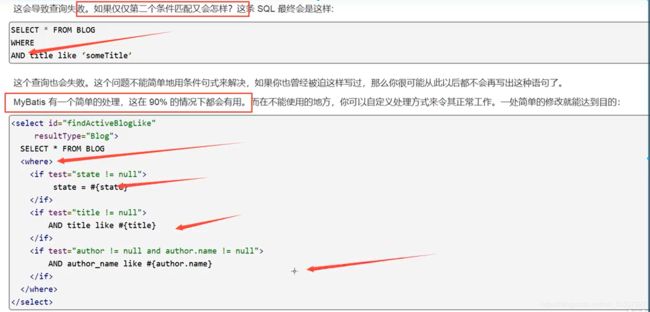
where 元素只会在子元素返回任何内容的情况下才插入 “WHERE” 子句。而且,若子句的开头为 “AND” 或 “OR”,where 元素也会将它们去除。
![]()
加上where智能去掉 and
![]()
<select id="queryBlogIF" parameterType="map" resultType="blog">
select * from mybatis.blog
<where>
<if test="title!=null">
and title=#{title}
</if>
<if test="author!=null">
and author=#{author}
</if>
</where>
</select>
trim (set)
//更新博客
int updateBlog(Map map);
<update id="updateBlog" parameterType="map">
update mybatis.blog
<set>
<if test="title!=null">
title=#{title},
</if>
<if test="author!=null">
author=#{author}
</if>
</set>
where id=#{id}
</update>
@Test
public void updateBlog(){
SqlSession sqlSession=MybatisUtils.getSqlSession();
BlogMapper mapper = sqlSession.getMapper(BlogMapper.class);
Map map=new HashMap();
map.put("title","Brendan Eich 真大佬~~~~~");
map.put("author","法外狂徒张三");
map.put("id","8fd57c04e2ec46c29e4ec18fbc2a52c8");
mapper.updateBlog(map);
sqlSession.close();
}
trim
5,SQL片段
有的时候,我们可以能会将一些功能的部分抽取出来,方便复用!
1,使用SQL标签抽取公共的部分
2,在需要使用的地方使用Include标签引用即可
<sql id="if-title-author">
<if test="title!=null">
and title=#{title}
</if>
<if test="author!=null">
and author=#{author}
</if>
</sql>
<select id="queryBlogIF" parameterType="map" resultType="blog">
select * from mybatis.blog
<where>
<include refid="if-title-author"></include>
</where>
</select>
注意事项:
最好基于单表来定义SQL片段!
不要存在where标签
6,Foreach
//查询第1-2-3号记录的博客
List queryBlogForeach(Map map);
<!--select * from mybatis.blog where 1=1 and(id=1 or id=2 or id=3)
传一个万能的Map,map中可以存在一个集合-->
<select id="queryBlogForeach" parameterType="map" resultType="blog">
select * from mybatis.blog
<where>
<foreach item="id" index="index" collection="ids"
open="and (" separator="or" close=")">
id = #{id}
</foreach>
</where>
</select>
@Test
public void queryBlogForeach(){
SqlSession sqlSession=MybatisUtils.getSqlSession();
BlogMapper mapper = sqlSession.getMapper(BlogMapper.class);
Map map=new HashMap();
ArrayList ids=new ArrayList();
ids.add(1);
ids.add(2);
ids.add(3);
map.put("ids",ids);
List blogs=mapper.queryBlogForeach(map);
for (Blog blog : blogs) {
System.out.println(blog);
}
sqlSession.close();
}
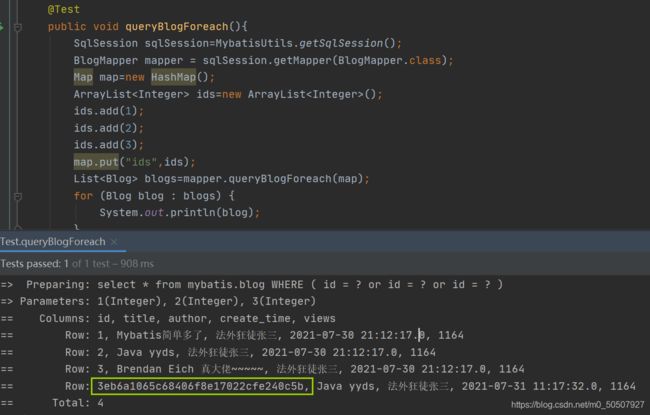
动态SQL就是在拼接SQL语句,我们只要保证SQL的正确性,按照SQL的格式,去排列组合就可以了。
建议:
先在Mysql中写出完整的SQL,再对应的去修改成我们的动态SQL实现通用即可!
十四,缓存
1,简介
查询 : 连接数据库,耗资源
一次查询的结果,给他暂存一个可以直接取到的地方 --> 内存:缓存
我们再次查询的相同数据的时候,直接走缓存,不走数据库了
1,什么是缓存[Cache]?
存在内存中的临时数据
将用户经常查询的数据放在缓存(内存)中,用户去查询数据就不用从磁盘上(关系型数据库文件)查询,从缓存中查询,从而提高查询效率,解决了高并发系统的性能问题
高并发系统的性能问题:
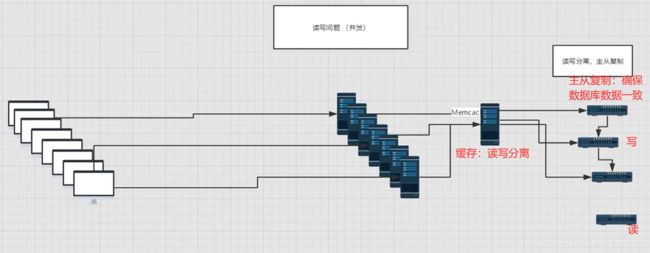
推荐文章:mysql主从复制原理
https://zhuanlan.zhihu.com/p/96212530
2,为什么使用缓存?
减少和数据库的交互次数,减少系统开销,提高系统效率
3,什么样的数据可以使用缓存?
经常查询并且不经常改变的数据 【可以使用缓存】
2,Mybatis缓存
1,MyBatis包含一个非常强大的查询缓存特性,它可以非常方便的定制和配置缓存,缓存可以极大的提高查询效率。
2,MyBatis系统中默认定义了两级缓存:一级缓存和二级缓存
(1)默认情况下,只有一级缓存开启(SqlSession级别的缓存,也称为本地缓存)
(2)二级缓存需要手动开启和配置,他是基于namespace级别的缓存。
(3)为了提高可扩展性,MyBatis定义了缓存接口Cache。我们可以通过实现Cache接口来定义二级缓存。
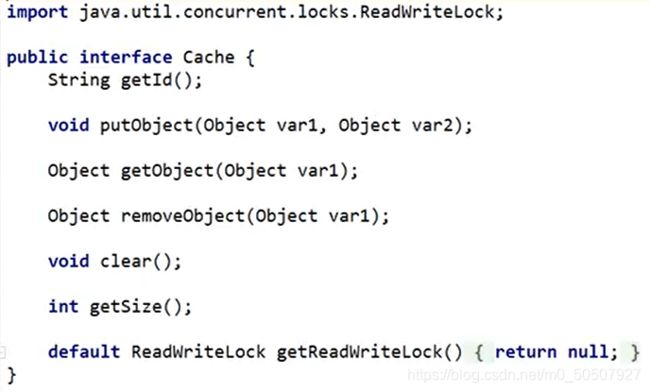
缓存策略:

3,一级缓存
一级缓存也叫本地缓存:
与数据库同一次会话期间查询到的数据会放在本地缓存中。
以后如果需要获取相同的数据,直接从缓存中拿,没必要再去查询数据库
测试步骤:
1,开启日志
2,测试在一个Session中查询两次相同记录
@Test
public void test() {
SqlSession sqlSession = MybatisUtils.getSqlSession();
UserMapper mapper = sqlSession.getMapper(UserMapper.class);
User user = mapper.queryUserById(1);
System.out.println(user);
System.out.println("====================");
User user2 = mapper.queryUserById(1);
System.out.println(user2);
System.out.println(user2 == user);
sqlSession.close();
}
缓存失效的情况:

1,查询不同的东西;
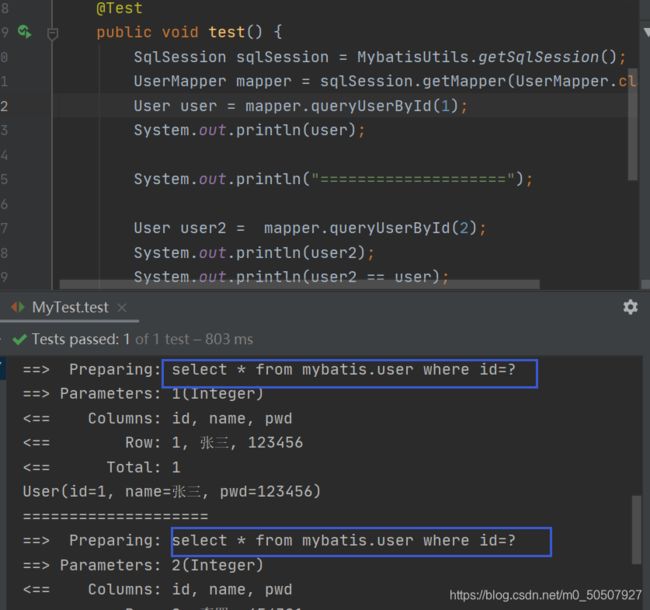
2,增删改操作,可能会改变原来的数据,所以必定会刷新缓存!
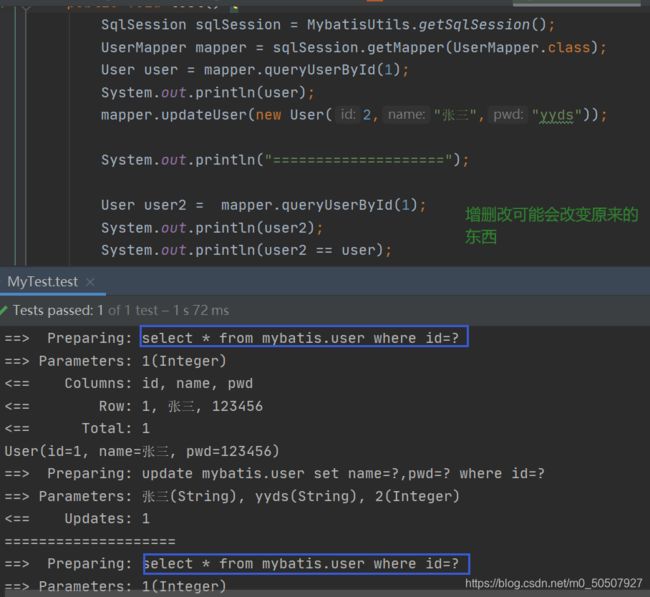
3,查询不同的Mapper.xml
不同的Mapper,二级缓存都不一样

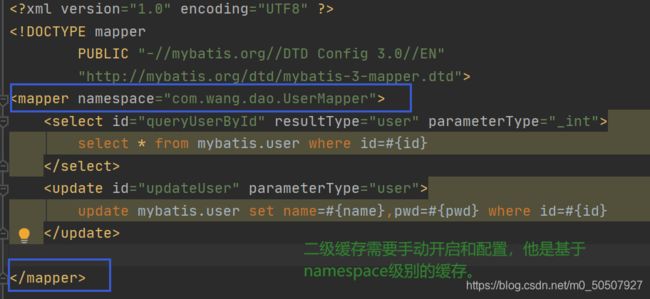
4,手动清理缓存!
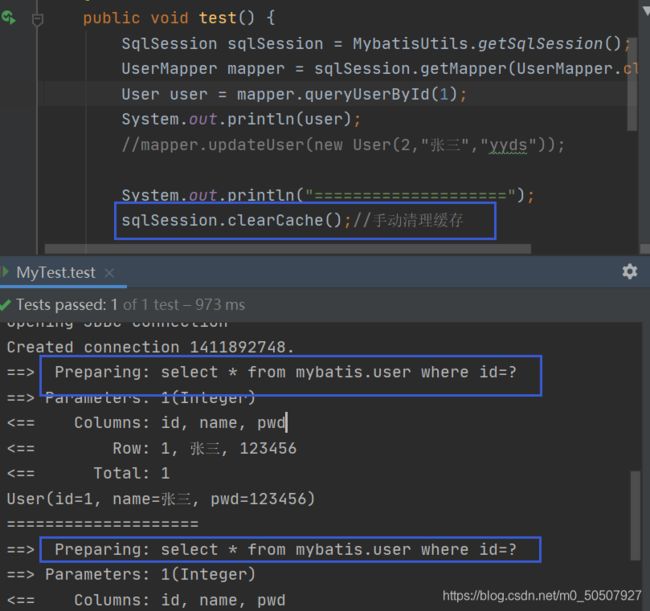
小结:一级缓存默认是开启的,只在一次SqlSession中有效,也就是拿到连接到关闭连接这个区间段!
一级缓存相当于一个Map。
4,二级缓存
二级缓存也叫全局缓存,一级缓存作用域太低了,所以诞生了二级缓存;
基于namespace级别的缓存,一个名称空间,对应一个二级缓存;
工作机制:
一个会话查询一条数据,这个数据就会被放在当前会话的一级缓存中;
如果当前会话关闭了,这个会话对应的一级缓存就没了;但是我们想要的是,会话关闭了,一级缓存中的数据被保存到二级缓存中;
新的会话查询信息,就可以从二级缓存中获取内容;
不同的mapper查出的数据就会放在自己对应的缓存(map)中;
一级缓存开启(SqlSession级别的缓存,也称为本地缓存)
二级缓存需要手动开启和配置,他是基于namespace级别的缓存。
为了提高可扩展性,MyBatis定义了缓存接口Cache。我们可以通过实现Cache接口来定义二级缓存。

步骤:
1,在mybatis-config.xml开启全局缓存
![]()
2,在要使用二级缓存的Mapper中开启
也可以自定义参数
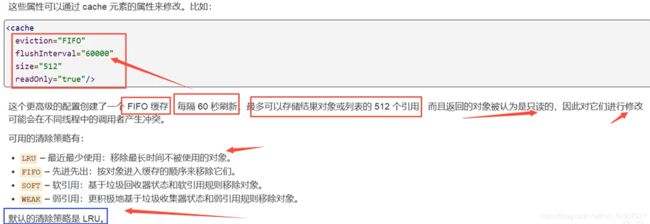
3,测试

4,org.apache.ibatis.cache.CacheException: Error serializing object.
Cause: java.io.NotSerializableException: com.wang.pojo.User
问题:如果没有自定义参数,则会报错,我们需要将实体类序列化!
@Data
@AllArgsConstructor
@NoArgsConstructor
public class User implements Serializable {
private int id;
private String name;
private String pwd;
}
5,小结:
只要开启了二级缓存,在同一个Mapper下就有效;
所有的数据都会先放在一级缓存中;
只有当会话提交或者关闭的时候,才会提交到二级缓存中!
5,缓存原理
6,自定义缓存-ehcache
Ehcache是一种广泛使用的开源Java分布式缓存。主要面向通用缓存
要在程序中使用ehcache要
1,导包
错误:
java.lang.NoClassDefFoundError: Could not initialize class net.sf.ehcache.CacheManager
org.mybatis
mybatis-ehcache
1.0.0
正确的包:
org.mybatis.caches
mybatis-ehcache
1.2.1
2,在mapper中指定使用我们的ehcache缓存实现
3,编写ehcache.xml文件,如果在加载时未找到/ehcache.xml资源或出现问题,则将使用默认配置。
<?xml version="1.0" encoding="UTF-8"?>
<ehcache xmlns:xsi="http://www.w3.org/2001/XMLSchema-instance"
xsi:noNamespaceSchemaLocation="http://ehcache.org/ehcache.xsd"
updateCheck="false">
<!--
diskStore:为缓存路径,ehcache分为内存和磁盘两级,此属性定义磁盘的缓存位置。参数解释如下:
user.home – 用户主目录
user.dir – 用户当前工作目录
java.io.tmpdir – 默认临时文件路径
-->
<diskStore path="./tmpdir/Tmp_EhCache"/>
<defaultCache
eternal="false"
maxElementsInMemory="10000"
overflowToDisk="false"
diskPersistent="false"
timeToIdleSeconds="1800"
timeToLiveSeconds="259200"
memoryStoreEvictionPolicy="LRU"/>
<cache
name="cloud_user"
eternal="false"
maxElementsInMemory="5000"
overflowToDisk="false"
diskPersistent="false"
timeToIdleSeconds="1800"
timeToLiveSeconds="1800"
memoryStoreEvictionPolicy="LRU"/>
<!--
defaultCache:默认缓存策略,当ehcache找不到定义的缓存时,则使用这个缓存策略。只能定义一个。
-->
<!--
name:缓存名称。
maxElementsInMemory:缓存最大数目
maxElementsOnDisk:硬盘最大缓存个数。
eternal:对象是否永久有效,一但设置了,timeout将不起作用。
overflowToDisk:是否保存到磁盘,当系统当机时
timeToIdleSeconds:设置对象在失效前的允许闲置时间(单位:秒)。仅当eternal=false对象不是永久有效时使用,可选属性,默认值是0,也就是可闲置时间无穷大。
timeToLiveSeconds:设置对象在失效前允许存活时间(单位:秒)。最大时间介于创建时间和失效时间之间。仅当eternal=false对象不是永久有效时使用,默认是0.,也就是对象存活时间无穷大。
diskPersistent:是否缓存虚拟机重启期数据 Whether the disk store persists between restarts of the Virtual Machine. The default value is false.
diskSpoolBufferSizeMB:这个参数设置DiskStore(磁盘缓存)的缓存区大小。默认是30MB。每个Cache都应该有自己的一个缓冲区。
diskExpiryThreadIntervalSeconds:磁盘失效线程运行时间间隔,默认是120秒。
memoryStoreEvictionPolicy:当达到maxElementsInMemory限制时,Ehcache将会根据指定的策略去清理内存。默认策略是LRU(最近最少使用)。你可以设置为FIFO(先进先出)或是LFU(较少使用)。
clearOnFlush:内存数量最大时是否清除。
memoryStoreEvictionPolicy:可选策略有:LRU(最近最少使用,默认策略)、FIFO(先进先出)、LFU(最少访问次数)。
FIFO,first in first out,这个是大家最熟的,先进先出。
LFU, Less Frequently Used,就是上面例子中使用的策略,直白一点就是讲一直以来最少被使用的。如上面所讲,缓存的元素有一个hit属性,hit值最小的将会被清出缓存。
LRU,Least Recently Used,最近最少使用的,缓存的元素有一个时间戳,当缓存容量满了,而又需要腾出地方来缓存新的元素的时候,那么现有缓存元素中时间戳离当前时间最远的元素将被清出缓存。
-->
</ehcache>
十五,gitee项目练习:
https://gitee.com/wangsen111111/smbms
